Psycho-Aspects of Care: Communication Skills and Patient Well-being
VerifiedAdded on 2023/01/13
|12
|2977
|37
Report
AI Summary
This report delves into the psycho-aspects of care and communication abilities vital in medicinal and generalist healthcare settings. It addresses the integration of psychosocial considerations in patient care, highlighting key recommendations for clinical preceptors to enhance student learning in this area. The report outlines a mental aid framework, emphasizing the importance of asking psychosocial questions, assessing learner knowledge, observing behavior, reflecting on interactions, and providing educational resources. It discusses common psychosocial situations like substance abuse, anxiety, and violence, stressing the necessity of tailored nursing interventions and the challenges faced by preceptors in teaching humanistic care. Furthermore, it differentiates between nursing interventions and assessments, underscoring the multidisciplinary nature of patient care and the significance of continuous quality improvement in healthcare settings. The report concludes by advocating for patient safety practices and fall prevention programs that prioritize patient autonomy and overall well-being, aligning with the acute care model.
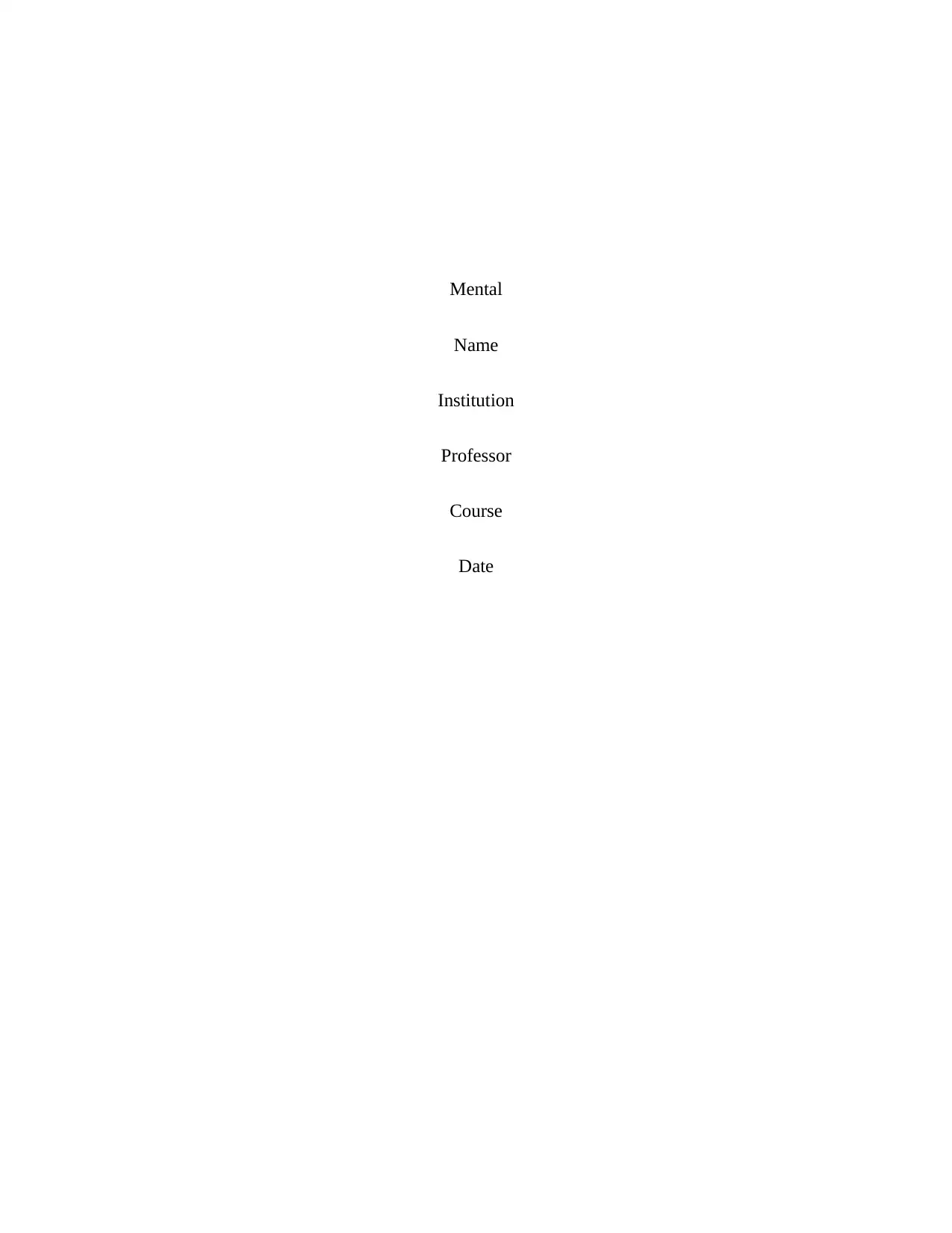
Mental
Name
Institution
Professor
Course
Date
Name
Institution
Professor
Course
Date
Paraphrase This Document
Need a fresh take? Get an instant paraphrase of this document with our AI Paraphraser
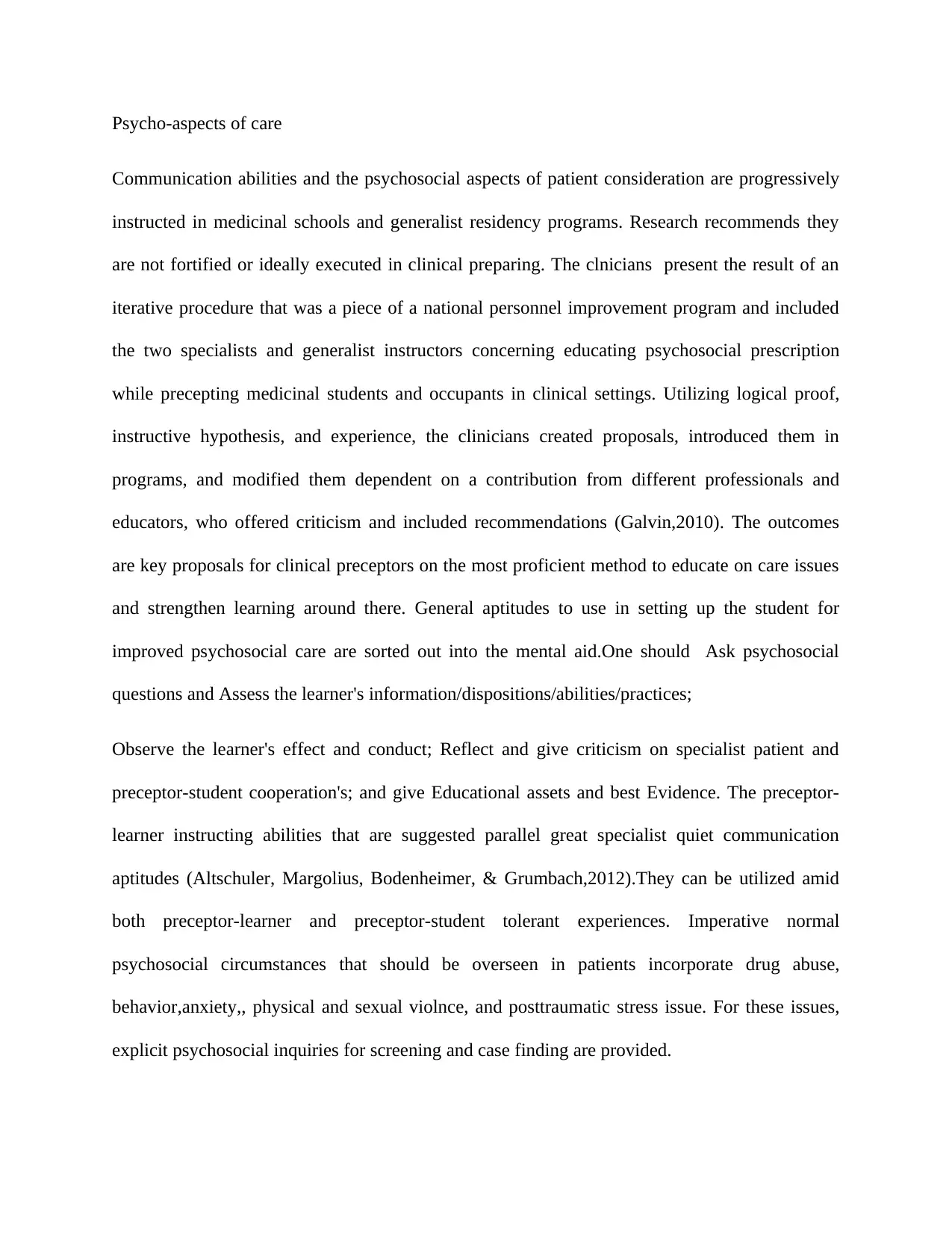
Psycho-aspects of care
Communication abilities and the psychosocial aspects of patient consideration are progressively
instructed in medicinal schools and generalist residency programs. Research recommends they
are not fortified or ideally executed in clinical preparing. The clnicians present the result of an
iterative procedure that was a piece of a national personnel improvement program and included
the two specialists and generalist instructors concerning educating psychosocial prescription
while precepting medicinal students and occupants in clinical settings. Utilizing logical proof,
instructive hypothesis, and experience, the clinicians created proposals, introduced them in
programs, and modified them dependent on a contribution from different professionals and
educators, who offered criticism and included recommendations (Galvin,2010). The outcomes
are key proposals for clinical preceptors on the most proficient method to educate on care issues
and strengthen learning around there. General aptitudes to use in setting up the student for
improved psychosocial care are sorted out into the mental aid.One should Ask psychosocial
questions and Assess the learner's information/dispositions/abilities/practices;
Observe the learner's effect and conduct; Reflect and give criticism on specialist patient and
preceptor-student cooperation's; and give Educational assets and best Evidence. The preceptor-
learner instructing abilities that are suggested parallel great specialist quiet communication
aptitudes (Altschuler, Margolius, Bodenheimer, & Grumbach,2012).They can be utilized amid
both preceptor-learner and preceptor-student tolerant experiences. Imperative normal
psychosocial circumstances that should be overseen in patients incorporate drug abuse,
behavior,anxiety,, physical and sexual violnce, and posttraumatic stress issue. For these issues,
explicit psychosocial inquiries for screening and case finding are provided.
Communication abilities and the psychosocial aspects of patient consideration are progressively
instructed in medicinal schools and generalist residency programs. Research recommends they
are not fortified or ideally executed in clinical preparing. The clnicians present the result of an
iterative procedure that was a piece of a national personnel improvement program and included
the two specialists and generalist instructors concerning educating psychosocial prescription
while precepting medicinal students and occupants in clinical settings. Utilizing logical proof,
instructive hypothesis, and experience, the clinicians created proposals, introduced them in
programs, and modified them dependent on a contribution from different professionals and
educators, who offered criticism and included recommendations (Galvin,2010). The outcomes
are key proposals for clinical preceptors on the most proficient method to educate on care issues
and strengthen learning around there. General aptitudes to use in setting up the student for
improved psychosocial care are sorted out into the mental aid.One should Ask psychosocial
questions and Assess the learner's information/dispositions/abilities/practices;
Observe the learner's effect and conduct; Reflect and give criticism on specialist patient and
preceptor-student cooperation's; and give Educational assets and best Evidence. The preceptor-
learner instructing abilities that are suggested parallel great specialist quiet communication
aptitudes (Altschuler, Margolius, Bodenheimer, & Grumbach,2012).They can be utilized amid
both preceptor-learner and preceptor-student tolerant experiences. Imperative normal
psychosocial circumstances that should be overseen in patients incorporate drug abuse,
behavior,anxiety,, physical and sexual violnce, and posttraumatic stress issue. For these issues,
explicit psychosocial inquiries for screening and case finding are provided.
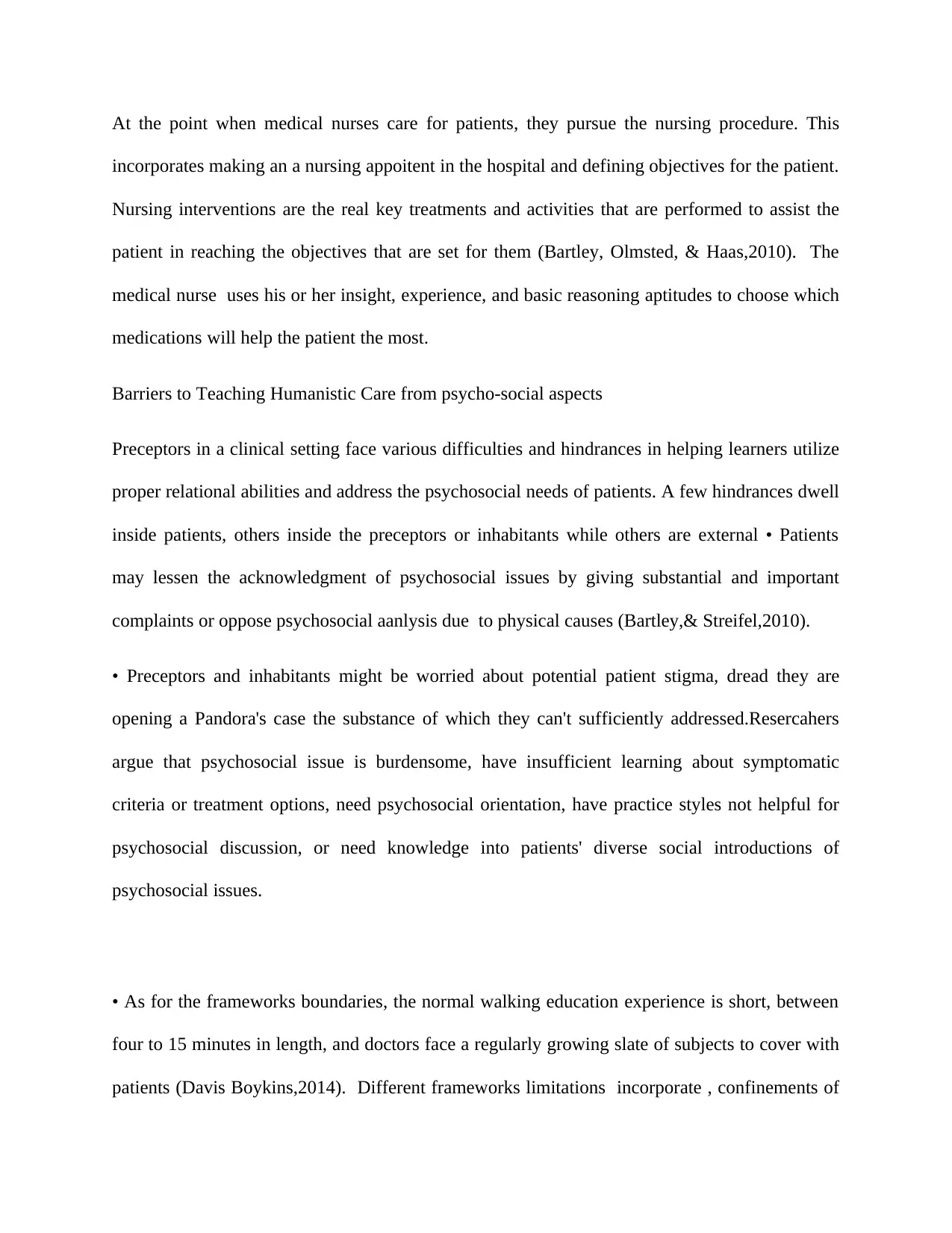
At the point when medical nurses care for patients, they pursue the nursing procedure. This
incorporates making an a nursing appoitent in the hospital and defining objectives for the patient.
Nursing interventions are the real key treatments and activities that are performed to assist the
patient in reaching the objectives that are set for them (Bartley, Olmsted, & Haas,2010). The
medical nurse uses his or her insight, experience, and basic reasoning aptitudes to choose which
medications will help the patient the most.
Barriers to Teaching Humanistic Care from psycho-social aspects
Preceptors in a clinical setting face various difficulties and hindrances in helping learners utilize
proper relational abilities and address the psychosocial needs of patients. A few hindrances dwell
inside patients, others inside the preceptors or inhabitants while others are external • Patients
may lessen the acknowledgment of psychosocial issues by giving substantial and important
complaints or oppose psychosocial aanlysis due to physical causes (Bartley,& Streifel,2010).
• Preceptors and inhabitants might be worried about potential patient stigma, dread they are
opening a Pandora's case the substance of which they can't sufficiently addressed.Resercahers
argue that psychosocial issue is burdensome, have insufficient learning about symptomatic
criteria or treatment options, need psychosocial orientation, have practice styles not helpful for
psychosocial discussion, or need knowledge into patients' diverse social introductions of
psychosocial issues.
• As for the frameworks boundaries, the normal walking education experience is short, between
four to 15 minutes in length, and doctors face a regularly growing slate of subjects to cover with
patients (Davis Boykins,2014). Different frameworks limitations incorporate , confinements of
incorporates making an a nursing appoitent in the hospital and defining objectives for the patient.
Nursing interventions are the real key treatments and activities that are performed to assist the
patient in reaching the objectives that are set for them (Bartley, Olmsted, & Haas,2010). The
medical nurse uses his or her insight, experience, and basic reasoning aptitudes to choose which
medications will help the patient the most.
Barriers to Teaching Humanistic Care from psycho-social aspects
Preceptors in a clinical setting face various difficulties and hindrances in helping learners utilize
proper relational abilities and address the psychosocial needs of patients. A few hindrances dwell
inside patients, others inside the preceptors or inhabitants while others are external • Patients
may lessen the acknowledgment of psychosocial issues by giving substantial and important
complaints or oppose psychosocial aanlysis due to physical causes (Bartley,& Streifel,2010).
• Preceptors and inhabitants might be worried about potential patient stigma, dread they are
opening a Pandora's case the substance of which they can't sufficiently addressed.Resercahers
argue that psychosocial issue is burdensome, have insufficient learning about symptomatic
criteria or treatment options, need psychosocial orientation, have practice styles not helpful for
psychosocial discussion, or need knowledge into patients' diverse social introductions of
psychosocial issues.
• As for the frameworks boundaries, the normal walking education experience is short, between
four to 15 minutes in length, and doctors face a regularly growing slate of subjects to cover with
patients (Davis Boykins,2014). Different frameworks limitations incorporate , confinements of
⊘ This is a preview!⊘
Do you want full access?
Subscribe today to unlock all pages.

Trusted by 1+ million students worldwide
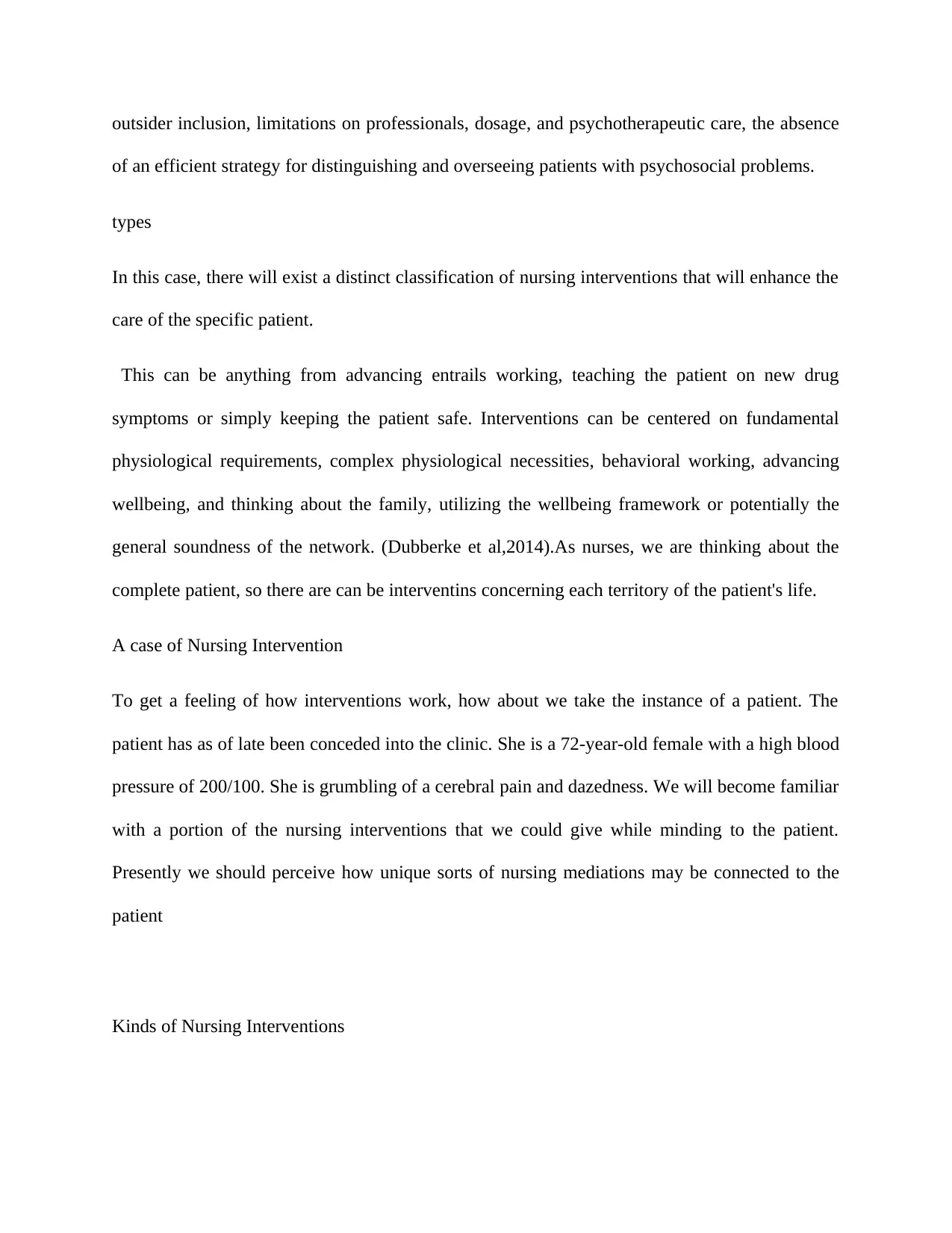
outsider inclusion, limitations on professionals, dosage, and psychotherapeutic care, the absence
of an efficient strategy for distinguishing and overseeing patients with psychosocial problems.
types
In this case, there will exist a distinct classification of nursing interventions that will enhance the
care of the specific patient.
This can be anything from advancing entrails working, teaching the patient on new drug
symptoms or simply keeping the patient safe. Interventions can be centered on fundamental
physiological requirements, complex physiological necessities, behavioral working, advancing
wellbeing, and thinking about the family, utilizing the wellbeing framework or potentially the
general soundness of the network. (Dubberke et al,2014).As nurses, we are thinking about the
complete patient, so there are can be interventins concerning each territory of the patient's life.
A case of Nursing Intervention
To get a feeling of how interventions work, how about we take the instance of a patient. The
patient has as of late been conceded into the clinic. She is a 72-year-old female with a high blood
pressure of 200/100. She is grumbling of a cerebral pain and dazedness. We will become familiar
with a portion of the nursing interventions that we could give while minding to the patient.
Presently we should perceive how unique sorts of nursing mediations may be connected to the
patient
Kinds of Nursing Interventions
of an efficient strategy for distinguishing and overseeing patients with psychosocial problems.
types
In this case, there will exist a distinct classification of nursing interventions that will enhance the
care of the specific patient.
This can be anything from advancing entrails working, teaching the patient on new drug
symptoms or simply keeping the patient safe. Interventions can be centered on fundamental
physiological requirements, complex physiological necessities, behavioral working, advancing
wellbeing, and thinking about the family, utilizing the wellbeing framework or potentially the
general soundness of the network. (Dubberke et al,2014).As nurses, we are thinking about the
complete patient, so there are can be interventins concerning each territory of the patient's life.
A case of Nursing Intervention
To get a feeling of how interventions work, how about we take the instance of a patient. The
patient has as of late been conceded into the clinic. She is a 72-year-old female with a high blood
pressure of 200/100. She is grumbling of a cerebral pain and dazedness. We will become familiar
with a portion of the nursing interventions that we could give while minding to the patient.
Presently we should perceive how unique sorts of nursing mediations may be connected to the
patient
Kinds of Nursing Interventions
Paraphrase This Document
Need a fresh take? Get an instant paraphrase of this document with our AI Paraphraser
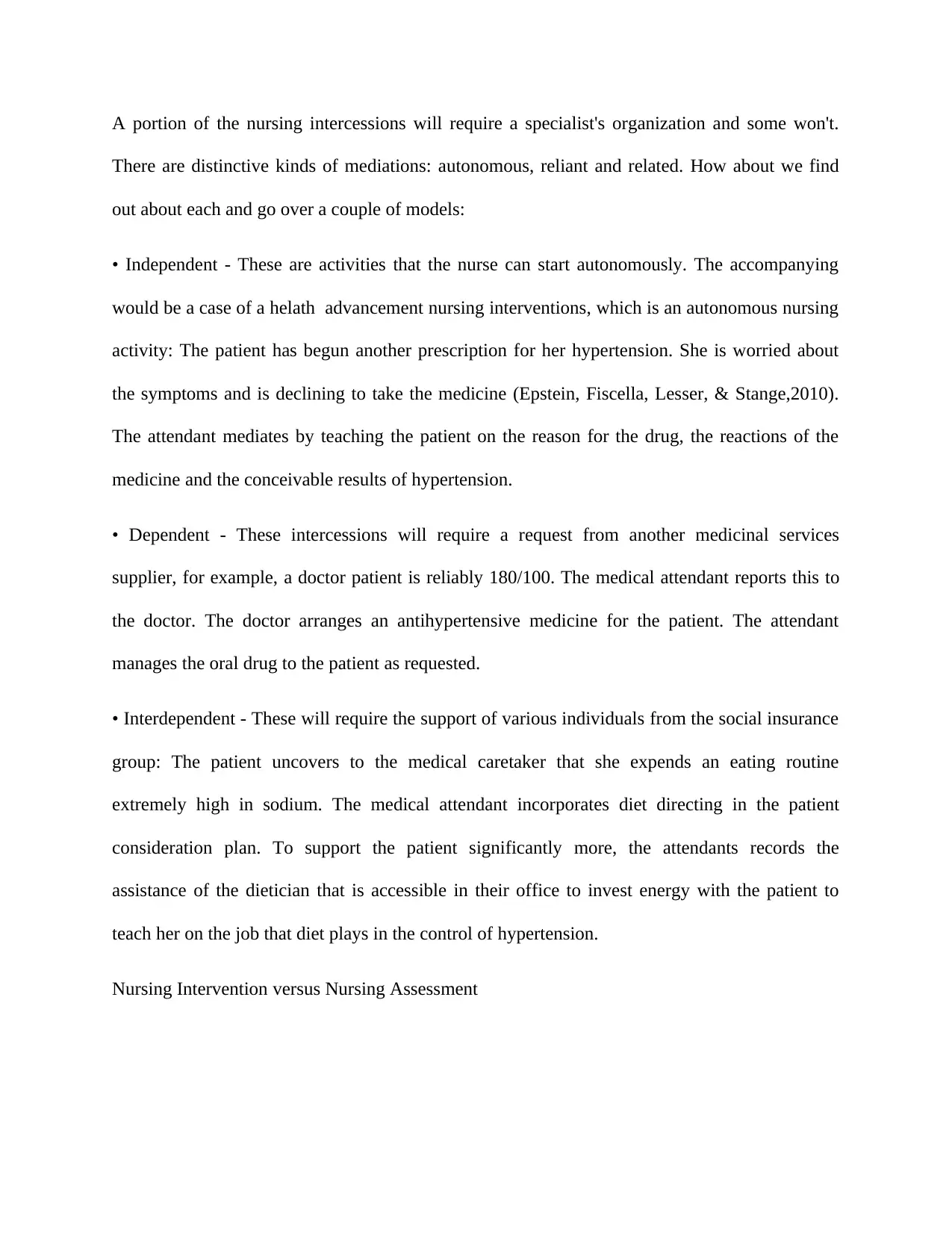
A portion of the nursing intercessions will require a specialist's organization and some won't.
There are distinctive kinds of mediations: autonomous, reliant and related. How about we find
out about each and go over a couple of models:
• Independent - These are activities that the nurse can start autonomously. The accompanying
would be a case of a helath advancement nursing interventions, which is an autonomous nursing
activity: The patient has begun another prescription for her hypertension. She is worried about
the symptoms and is declining to take the medicine (Epstein, Fiscella, Lesser, & Stange,2010).
The attendant mediates by teaching the patient on the reason for the drug, the reactions of the
medicine and the conceivable results of hypertension.
• Dependent - These intercessions will require a request from another medicinal services
supplier, for example, a doctor patient is reliably 180/100. The medical attendant reports this to
the doctor. The doctor arranges an antihypertensive medicine for the patient. The attendant
manages the oral drug to the patient as requested.
• Interdependent - These will require the support of various individuals from the social insurance
group: The patient uncovers to the medical caretaker that she expends an eating routine
extremely high in sodium. The medical attendant incorporates diet directing in the patient
consideration plan. To support the patient significantly more, the attendants records the
assistance of the dietician that is accessible in their office to invest energy with the patient to
teach her on the job that diet plays in the control of hypertension.
Nursing Intervention versus Nursing Assessment
There are distinctive kinds of mediations: autonomous, reliant and related. How about we find
out about each and go over a couple of models:
• Independent - These are activities that the nurse can start autonomously. The accompanying
would be a case of a helath advancement nursing interventions, which is an autonomous nursing
activity: The patient has begun another prescription for her hypertension. She is worried about
the symptoms and is declining to take the medicine (Epstein, Fiscella, Lesser, & Stange,2010).
The attendant mediates by teaching the patient on the reason for the drug, the reactions of the
medicine and the conceivable results of hypertension.
• Dependent - These intercessions will require a request from another medicinal services
supplier, for example, a doctor patient is reliably 180/100. The medical attendant reports this to
the doctor. The doctor arranges an antihypertensive medicine for the patient. The attendant
manages the oral drug to the patient as requested.
• Interdependent - These will require the support of various individuals from the social insurance
group: The patient uncovers to the medical caretaker that she expends an eating routine
extremely high in sodium. The medical attendant incorporates diet directing in the patient
consideration plan. To support the patient significantly more, the attendants records the
assistance of the dietician that is accessible in their office to invest energy with the patient to
teach her on the job that diet plays in the control of hypertension.
Nursing Intervention versus Nursing Assessment
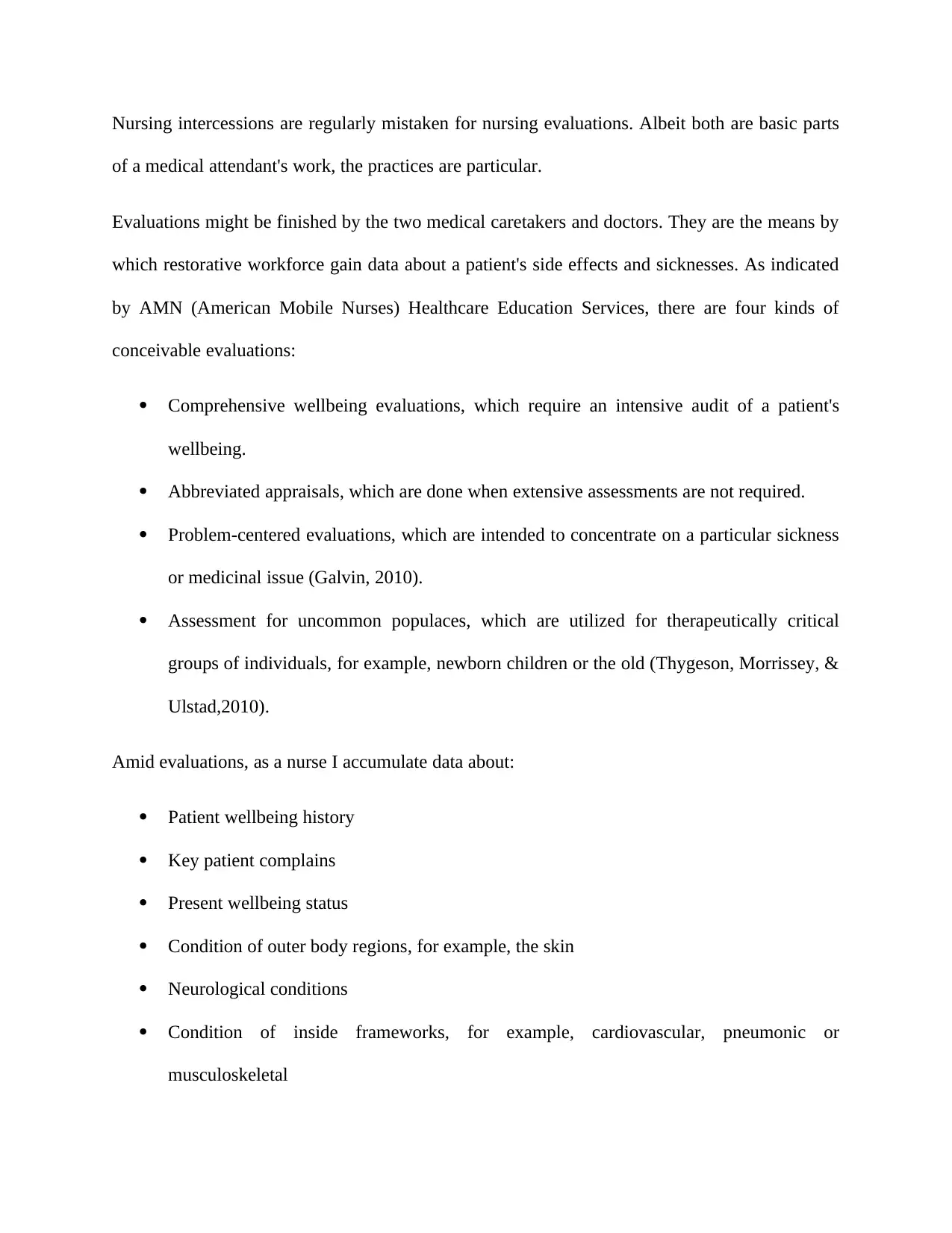
Nursing intercessions are regularly mistaken for nursing evaluations. Albeit both are basic parts
of a medical attendant's work, the practices are particular.
Evaluations might be finished by the two medical caretakers and doctors. They are the means by
which restorative workforce gain data about a patient's side effects and sicknesses. As indicated
by AMN (American Mobile Nurses) Healthcare Education Services, there are four kinds of
conceivable evaluations:
Comprehensive wellbeing evaluations, which require an intensive audit of a patient's
wellbeing.
Abbreviated appraisals, which are done when extensive assessments are not required.
Problem-centered evaluations, which are intended to concentrate on a particular sickness
or medicinal issue (Galvin, 2010).
Assessment for uncommon populaces, which are utilized for therapeutically critical
groups of individuals, for example, newborn children or the old (Thygeson, Morrissey, &
Ulstad,2010).
Amid evaluations, as a nurse I accumulate data about:
Patient wellbeing history
Key patient complains
Present wellbeing status
Condition of outer body regions, for example, the skin
Neurological conditions
Condition of inside frameworks, for example, cardiovascular, pneumonic or
musculoskeletal
of a medical attendant's work, the practices are particular.
Evaluations might be finished by the two medical caretakers and doctors. They are the means by
which restorative workforce gain data about a patient's side effects and sicknesses. As indicated
by AMN (American Mobile Nurses) Healthcare Education Services, there are four kinds of
conceivable evaluations:
Comprehensive wellbeing evaluations, which require an intensive audit of a patient's
wellbeing.
Abbreviated appraisals, which are done when extensive assessments are not required.
Problem-centered evaluations, which are intended to concentrate on a particular sickness
or medicinal issue (Galvin, 2010).
Assessment for uncommon populaces, which are utilized for therapeutically critical
groups of individuals, for example, newborn children or the old (Thygeson, Morrissey, &
Ulstad,2010).
Amid evaluations, as a nurse I accumulate data about:
Patient wellbeing history
Key patient complains
Present wellbeing status
Condition of outer body regions, for example, the skin
Neurological conditions
Condition of inside frameworks, for example, cardiovascular, pneumonic or
musculoskeletal
⊘ This is a preview!⊘
Do you want full access?
Subscribe today to unlock all pages.

Trusted by 1+ million students worldwide
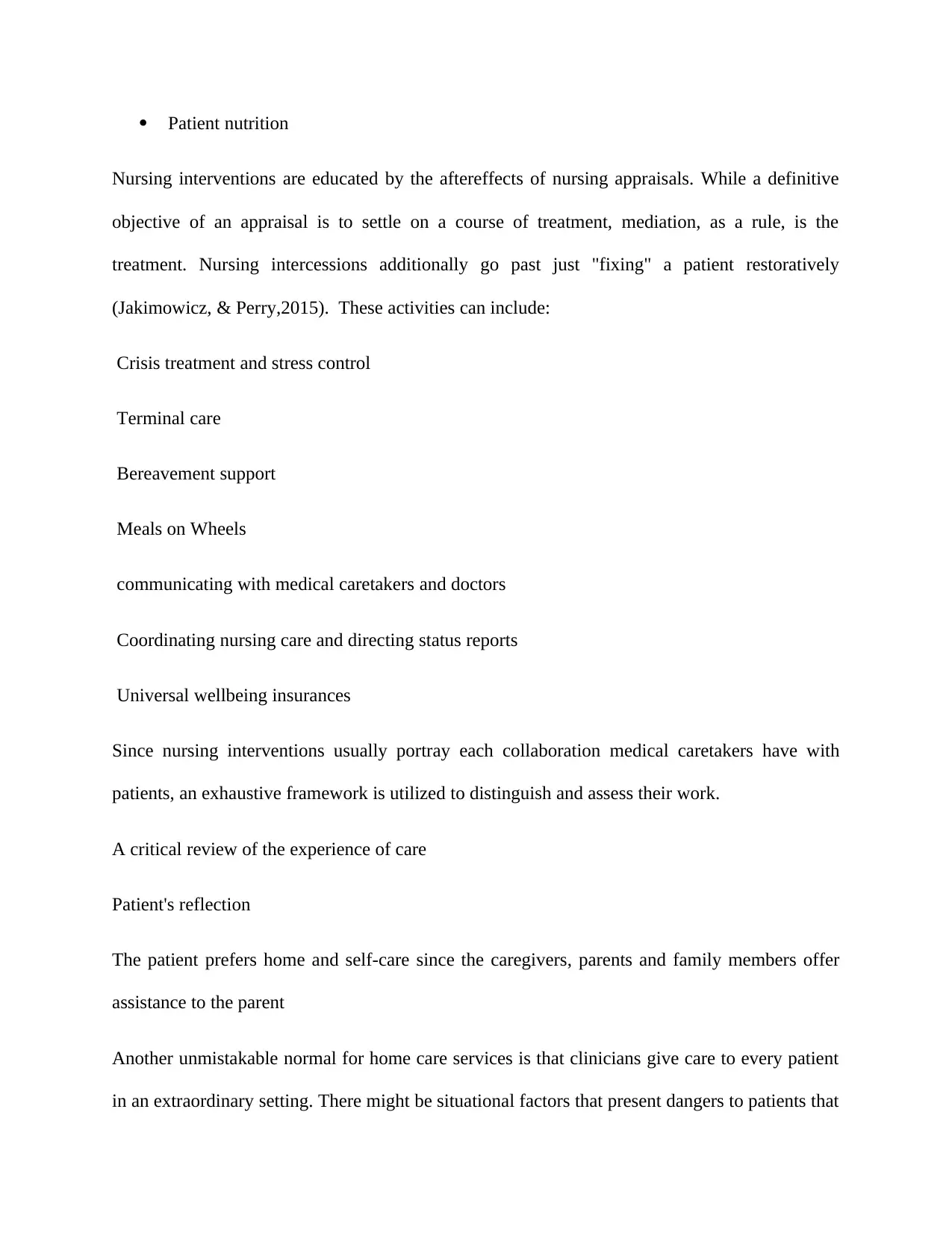
Patient nutrition
Nursing interventions are educated by the aftereffects of nursing appraisals. While a definitive
objective of an appraisal is to settle on a course of treatment, mediation, as a rule, is the
treatment. Nursing intercessions additionally go past just "fixing" a patient restoratively
(Jakimowicz, & Perry,2015). These activities can include:
Crisis treatment and stress control
Terminal care
Bereavement support
Meals on Wheels
communicating with medical caretakers and doctors
Coordinating nursing care and directing status reports
Universal wellbeing insurances
Since nursing interventions usually portray each collaboration medical caretakers have with
patients, an exhaustive framework is utilized to distinguish and assess their work.
A critical review of the experience of care
Patient's reflection
The patient prefers home and self-care since the caregivers, parents and family members offer
assistance to the parent
Another unmistakable normal for home care services is that clinicians give care to every patient
in an extraordinary setting. There might be situational factors that present dangers to patients that
Nursing interventions are educated by the aftereffects of nursing appraisals. While a definitive
objective of an appraisal is to settle on a course of treatment, mediation, as a rule, is the
treatment. Nursing intercessions additionally go past just "fixing" a patient restoratively
(Jakimowicz, & Perry,2015). These activities can include:
Crisis treatment and stress control
Terminal care
Bereavement support
Meals on Wheels
communicating with medical caretakers and doctors
Coordinating nursing care and directing status reports
Universal wellbeing insurances
Since nursing interventions usually portray each collaboration medical caretakers have with
patients, an exhaustive framework is utilized to distinguish and assess their work.
A critical review of the experience of care
Patient's reflection
The patient prefers home and self-care since the caregivers, parents and family members offer
assistance to the parent
Another unmistakable normal for home care services is that clinicians give care to every patient
in an extraordinary setting. There might be situational factors that present dangers to patients that
Paraphrase This Document
Need a fresh take? Get an instant paraphrase of this document with our AI Paraphraser
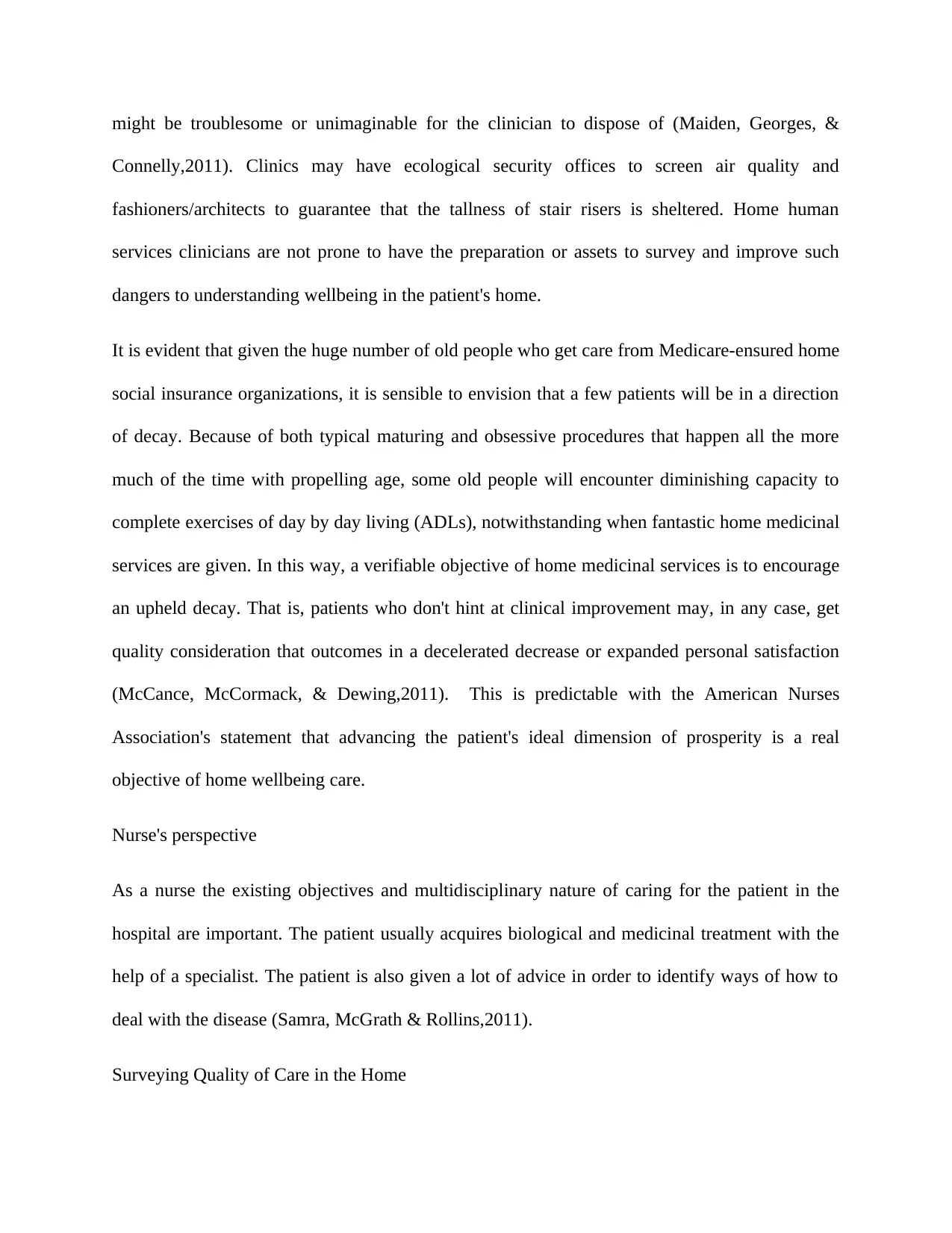
might be troublesome or unimaginable for the clinician to dispose of (Maiden, Georges, &
Connelly,2011). Clinics may have ecological security offices to screen air quality and
fashioners/architects to guarantee that the tallness of stair risers is sheltered. Home human
services clinicians are not prone to have the preparation or assets to survey and improve such
dangers to understanding wellbeing in the patient's home.
It is evident that given the huge number of old people who get care from Medicare-ensured home
social insurance organizations, it is sensible to envision that a few patients will be in a direction
of decay. Because of both typical maturing and obsessive procedures that happen all the more
much of the time with propelling age, some old people will encounter diminishing capacity to
complete exercises of day by day living (ADLs), notwithstanding when fantastic home medicinal
services are given. In this way, a verifiable objective of home medicinal services is to encourage
an upheld decay. That is, patients who don't hint at clinical improvement may, in any case, get
quality consideration that outcomes in a decelerated decrease or expanded personal satisfaction
(McCance, McCormack, & Dewing,2011). This is predictable with the American Nurses
Association's statement that advancing the patient's ideal dimension of prosperity is a real
objective of home wellbeing care.
Nurse's perspective
As a nurse the existing objectives and multidisciplinary nature of caring for the patient in the
hospital are important. The patient usually acquires biological and medicinal treatment with the
help of a specialist. The patient is also given a lot of advice in order to identify ways of how to
deal with the disease (Samra, McGrath & Rollins,2011).
Surveying Quality of Care in the Home
Connelly,2011). Clinics may have ecological security offices to screen air quality and
fashioners/architects to guarantee that the tallness of stair risers is sheltered. Home human
services clinicians are not prone to have the preparation or assets to survey and improve such
dangers to understanding wellbeing in the patient's home.
It is evident that given the huge number of old people who get care from Medicare-ensured home
social insurance organizations, it is sensible to envision that a few patients will be in a direction
of decay. Because of both typical maturing and obsessive procedures that happen all the more
much of the time with propelling age, some old people will encounter diminishing capacity to
complete exercises of day by day living (ADLs), notwithstanding when fantastic home medicinal
services are given. In this way, a verifiable objective of home medicinal services is to encourage
an upheld decay. That is, patients who don't hint at clinical improvement may, in any case, get
quality consideration that outcomes in a decelerated decrease or expanded personal satisfaction
(McCance, McCormack, & Dewing,2011). This is predictable with the American Nurses
Association's statement that advancing the patient's ideal dimension of prosperity is a real
objective of home wellbeing care.
Nurse's perspective
As a nurse the existing objectives and multidisciplinary nature of caring for the patient in the
hospital are important. The patient usually acquires biological and medicinal treatment with the
help of a specialist. The patient is also given a lot of advice in order to identify ways of how to
deal with the disease (Samra, McGrath & Rollins,2011).
Surveying Quality of Care in the Home
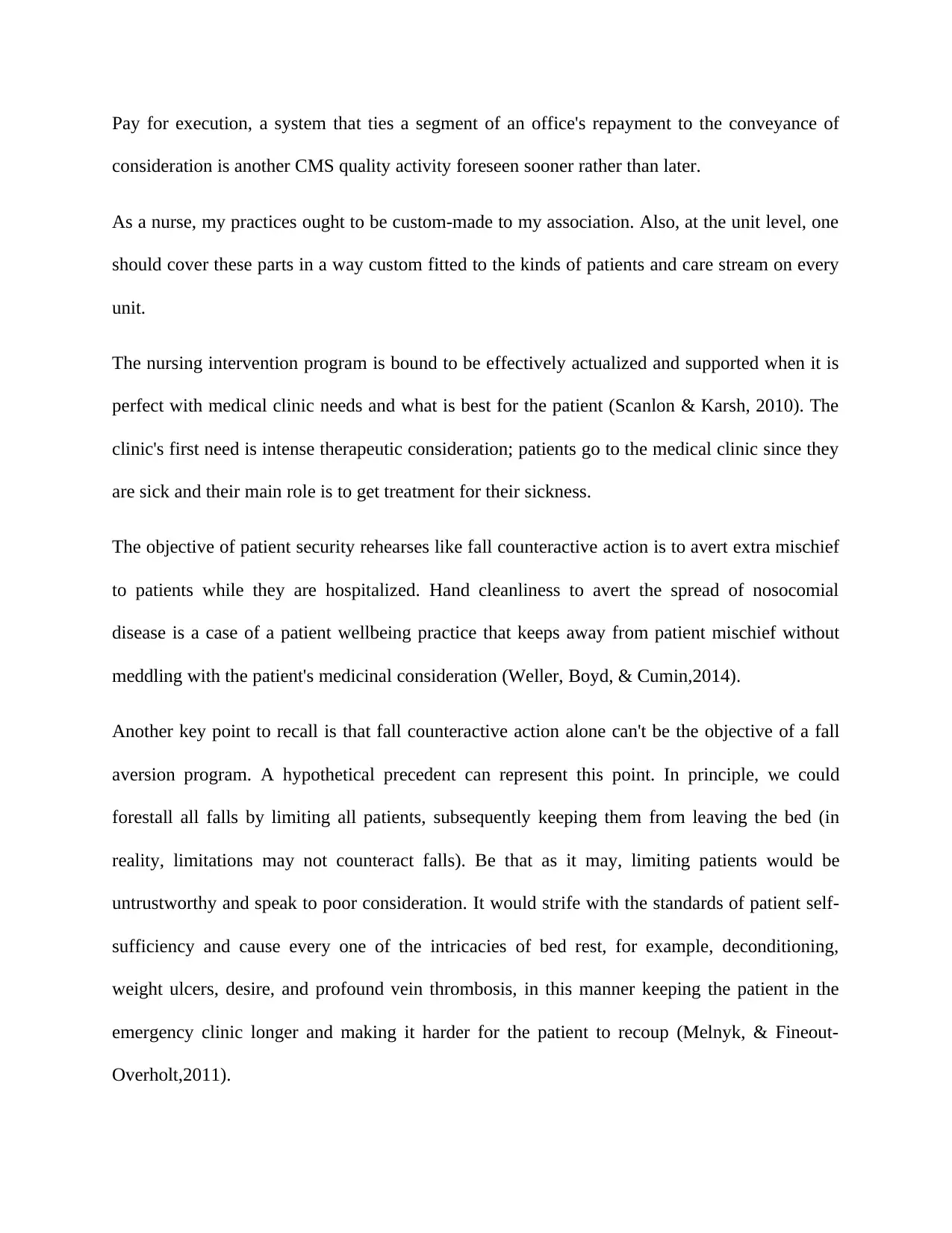
Pay for execution, a system that ties a segment of an office's repayment to the conveyance of
consideration is another CMS quality activity foreseen sooner rather than later.
As a nurse, my practices ought to be custom-made to my association. Also, at the unit level, one
should cover these parts in a way custom fitted to the kinds of patients and care stream on every
unit.
The nursing intervention program is bound to be effectively actualized and supported when it is
perfect with medical clinic needs and what is best for the patient (Scanlon & Karsh, 2010). The
clinic's first need is intense therapeutic consideration; patients go to the medical clinic since they
are sick and their main role is to get treatment for their sickness.
The objective of patient security rehearses like fall counteractive action is to avert extra mischief
to patients while they are hospitalized. Hand cleanliness to avert the spread of nosocomial
disease is a case of a patient wellbeing practice that keeps away from patient mischief without
meddling with the patient's medicinal consideration (Weller, Boyd, & Cumin,2014).
Another key point to recall is that fall counteractive action alone can't be the objective of a fall
aversion program. A hypothetical precedent can represent this point. In principle, we could
forestall all falls by limiting all patients, subsequently keeping them from leaving the bed (in
reality, limitations may not counteract falls). Be that as it may, limiting patients would be
untrustworthy and speak to poor consideration. It would strife with the standards of patient self-
sufficiency and cause every one of the intricacies of bed rest, for example, deconditioning,
weight ulcers, desire, and profound vein thrombosis, in this manner keeping the patient in the
emergency clinic longer and making it harder for the patient to recoup (Melnyk, & Fineout-
Overholt,2011).
consideration is another CMS quality activity foreseen sooner rather than later.
As a nurse, my practices ought to be custom-made to my association. Also, at the unit level, one
should cover these parts in a way custom fitted to the kinds of patients and care stream on every
unit.
The nursing intervention program is bound to be effectively actualized and supported when it is
perfect with medical clinic needs and what is best for the patient (Scanlon & Karsh, 2010). The
clinic's first need is intense therapeutic consideration; patients go to the medical clinic since they
are sick and their main role is to get treatment for their sickness.
The objective of patient security rehearses like fall counteractive action is to avert extra mischief
to patients while they are hospitalized. Hand cleanliness to avert the spread of nosocomial
disease is a case of a patient wellbeing practice that keeps away from patient mischief without
meddling with the patient's medicinal consideration (Weller, Boyd, & Cumin,2014).
Another key point to recall is that fall counteractive action alone can't be the objective of a fall
aversion program. A hypothetical precedent can represent this point. In principle, we could
forestall all falls by limiting all patients, subsequently keeping them from leaving the bed (in
reality, limitations may not counteract falls). Be that as it may, limiting patients would be
untrustworthy and speak to poor consideration. It would strife with the standards of patient self-
sufficiency and cause every one of the intricacies of bed rest, for example, deconditioning,
weight ulcers, desire, and profound vein thrombosis, in this manner keeping the patient in the
emergency clinic longer and making it harder for the patient to recoup (Melnyk, & Fineout-
Overholt,2011).
⊘ This is a preview!⊘
Do you want full access?
Subscribe today to unlock all pages.

Trusted by 1+ million students worldwide
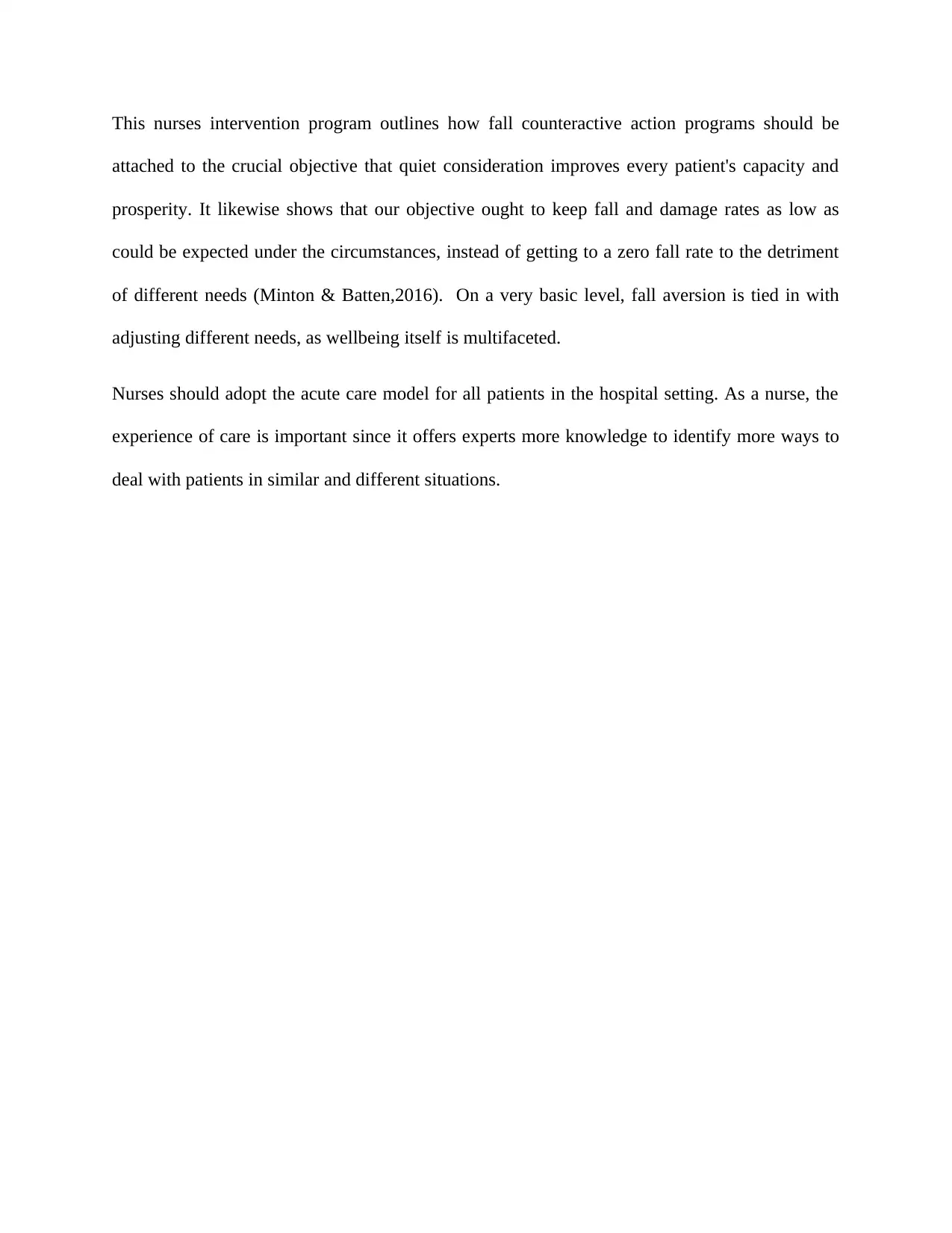
This nurses intervention program outlines how fall counteractive action programs should be
attached to the crucial objective that quiet consideration improves every patient's capacity and
prosperity. It likewise shows that our objective ought to keep fall and damage rates as low as
could be expected under the circumstances, instead of getting to a zero fall rate to the detriment
of different needs (Minton & Batten,2016). On a very basic level, fall aversion is tied in with
adjusting different needs, as wellbeing itself is multifaceted.
Nurses should adopt the acute care model for all patients in the hospital setting. As a nurse, the
experience of care is important since it offers experts more knowledge to identify more ways to
deal with patients in similar and different situations.
attached to the crucial objective that quiet consideration improves every patient's capacity and
prosperity. It likewise shows that our objective ought to keep fall and damage rates as low as
could be expected under the circumstances, instead of getting to a zero fall rate to the detriment
of different needs (Minton & Batten,2016). On a very basic level, fall aversion is tied in with
adjusting different needs, as wellbeing itself is multifaceted.
Nurses should adopt the acute care model for all patients in the hospital setting. As a nurse, the
experience of care is important since it offers experts more knowledge to identify more ways to
deal with patients in similar and different situations.
Paraphrase This Document
Need a fresh take? Get an instant paraphrase of this document with our AI Paraphraser
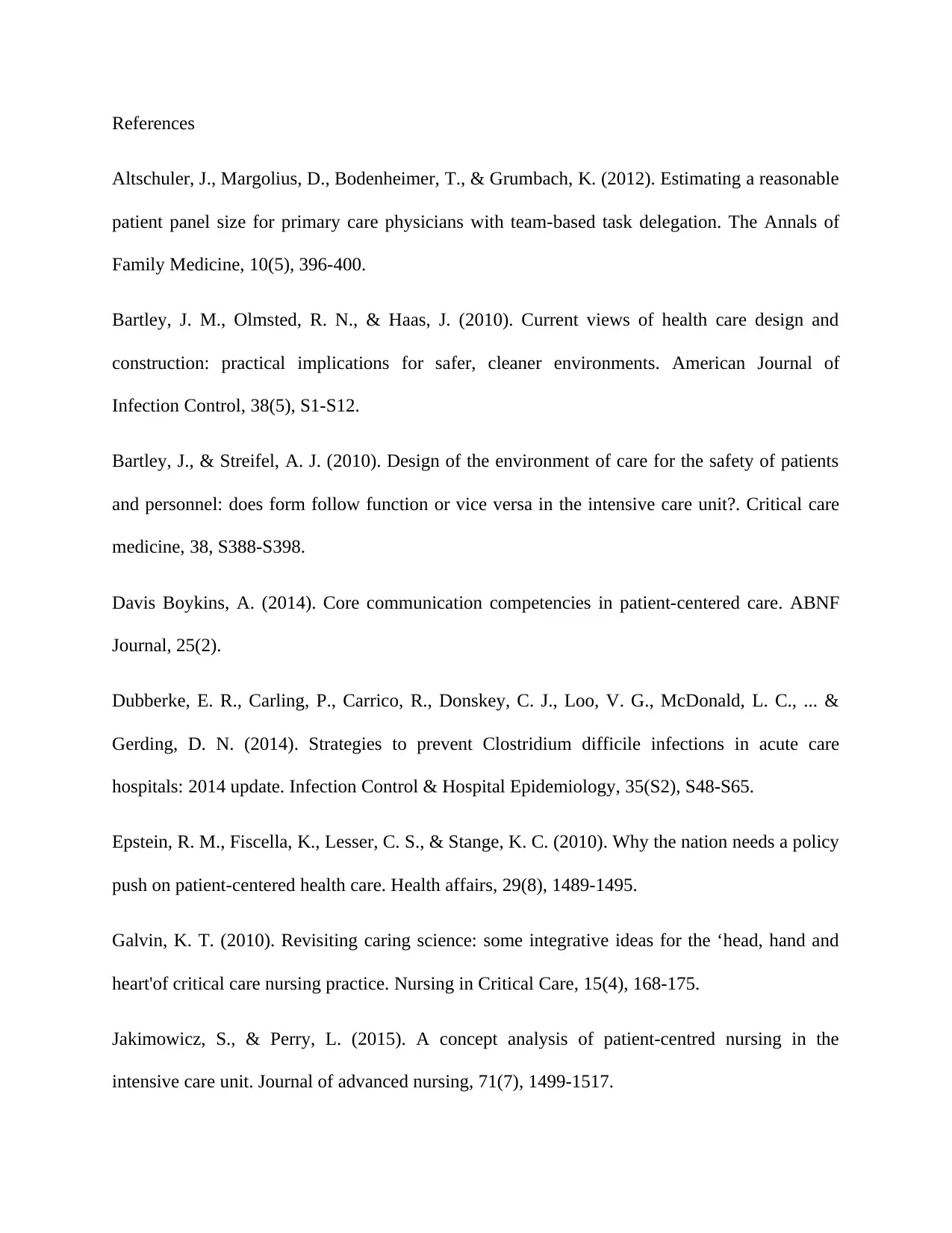
References
Altschuler, J., Margolius, D., Bodenheimer, T., & Grumbach, K. (2012). Estimating a reasonable
patient panel size for primary care physicians with team-based task delegation. The Annals of
Family Medicine, 10(5), 396-400.
Bartley, J. M., Olmsted, R. N., & Haas, J. (2010). Current views of health care design and
construction: practical implications for safer, cleaner environments. American Journal of
Infection Control, 38(5), S1-S12.
Bartley, J., & Streifel, A. J. (2010). Design of the environment of care for the safety of patients
and personnel: does form follow function or vice versa in the intensive care unit?. Critical care
medicine, 38, S388-S398.
Davis Boykins, A. (2014). Core communication competencies in patient-centered care. ABNF
Journal, 25(2).
Dubberke, E. R., Carling, P., Carrico, R., Donskey, C. J., Loo, V. G., McDonald, L. C., ... &
Gerding, D. N. (2014). Strategies to prevent Clostridium difficile infections in acute care
hospitals: 2014 update. Infection Control & Hospital Epidemiology, 35(S2), S48-S65.
Epstein, R. M., Fiscella, K., Lesser, C. S., & Stange, K. C. (2010). Why the nation needs a policy
push on patient-centered health care. Health affairs, 29(8), 1489-1495.
Galvin, K. T. (2010). Revisiting caring science: some integrative ideas for the ‘head, hand and
heart'of critical care nursing practice. Nursing in Critical Care, 15(4), 168-175.
Jakimowicz, S., & Perry, L. (2015). A concept analysis of patient‐centred nursing in the
intensive care unit. Journal of advanced nursing, 71(7), 1499-1517.
Altschuler, J., Margolius, D., Bodenheimer, T., & Grumbach, K. (2012). Estimating a reasonable
patient panel size for primary care physicians with team-based task delegation. The Annals of
Family Medicine, 10(5), 396-400.
Bartley, J. M., Olmsted, R. N., & Haas, J. (2010). Current views of health care design and
construction: practical implications for safer, cleaner environments. American Journal of
Infection Control, 38(5), S1-S12.
Bartley, J., & Streifel, A. J. (2010). Design of the environment of care for the safety of patients
and personnel: does form follow function or vice versa in the intensive care unit?. Critical care
medicine, 38, S388-S398.
Davis Boykins, A. (2014). Core communication competencies in patient-centered care. ABNF
Journal, 25(2).
Dubberke, E. R., Carling, P., Carrico, R., Donskey, C. J., Loo, V. G., McDonald, L. C., ... &
Gerding, D. N. (2014). Strategies to prevent Clostridium difficile infections in acute care
hospitals: 2014 update. Infection Control & Hospital Epidemiology, 35(S2), S48-S65.
Epstein, R. M., Fiscella, K., Lesser, C. S., & Stange, K. C. (2010). Why the nation needs a policy
push on patient-centered health care. Health affairs, 29(8), 1489-1495.
Galvin, K. T. (2010). Revisiting caring science: some integrative ideas for the ‘head, hand and
heart'of critical care nursing practice. Nursing in Critical Care, 15(4), 168-175.
Jakimowicz, S., & Perry, L. (2015). A concept analysis of patient‐centred nursing in the
intensive care unit. Journal of advanced nursing, 71(7), 1499-1517.
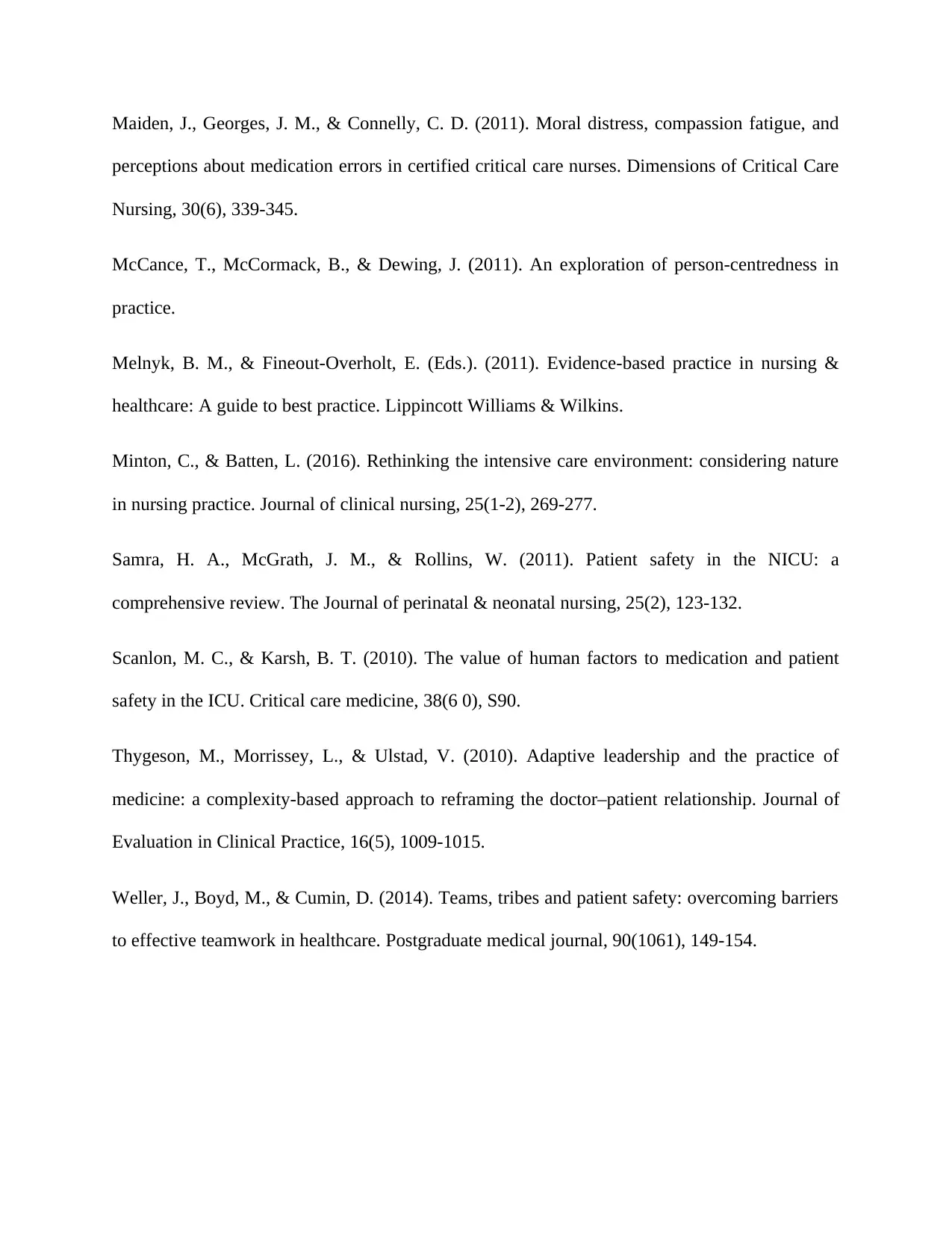
Maiden, J., Georges, J. M., & Connelly, C. D. (2011). Moral distress, compassion fatigue, and
perceptions about medication errors in certified critical care nurses. Dimensions of Critical Care
Nursing, 30(6), 339-345.
McCance, T., McCormack, B., & Dewing, J. (2011). An exploration of person-centredness in
practice.
Melnyk, B. M., & Fineout-Overholt, E. (Eds.). (2011). Evidence-based practice in nursing &
healthcare: A guide to best practice. Lippincott Williams & Wilkins.
Minton, C., & Batten, L. (2016). Rethinking the intensive care environment: considering nature
in nursing practice. Journal of clinical nursing, 25(1-2), 269-277.
Samra, H. A., McGrath, J. M., & Rollins, W. (2011). Patient safety in the NICU: a
comprehensive review. The Journal of perinatal & neonatal nursing, 25(2), 123-132.
Scanlon, M. C., & Karsh, B. T. (2010). The value of human factors to medication and patient
safety in the ICU. Critical care medicine, 38(6 0), S90.
Thygeson, M., Morrissey, L., & Ulstad, V. (2010). Adaptive leadership and the practice of
medicine: a complexity‐based approach to reframing the doctor–patient relationship. Journal of
Evaluation in Clinical Practice, 16(5), 1009-1015.
Weller, J., Boyd, M., & Cumin, D. (2014). Teams, tribes and patient safety: overcoming barriers
to effective teamwork in healthcare. Postgraduate medical journal, 90(1061), 149-154.
perceptions about medication errors in certified critical care nurses. Dimensions of Critical Care
Nursing, 30(6), 339-345.
McCance, T., McCormack, B., & Dewing, J. (2011). An exploration of person-centredness in
practice.
Melnyk, B. M., & Fineout-Overholt, E. (Eds.). (2011). Evidence-based practice in nursing &
healthcare: A guide to best practice. Lippincott Williams & Wilkins.
Minton, C., & Batten, L. (2016). Rethinking the intensive care environment: considering nature
in nursing practice. Journal of clinical nursing, 25(1-2), 269-277.
Samra, H. A., McGrath, J. M., & Rollins, W. (2011). Patient safety in the NICU: a
comprehensive review. The Journal of perinatal & neonatal nursing, 25(2), 123-132.
Scanlon, M. C., & Karsh, B. T. (2010). The value of human factors to medication and patient
safety in the ICU. Critical care medicine, 38(6 0), S90.
Thygeson, M., Morrissey, L., & Ulstad, V. (2010). Adaptive leadership and the practice of
medicine: a complexity‐based approach to reframing the doctor–patient relationship. Journal of
Evaluation in Clinical Practice, 16(5), 1009-1015.
Weller, J., Boyd, M., & Cumin, D. (2014). Teams, tribes and patient safety: overcoming barriers
to effective teamwork in healthcare. Postgraduate medical journal, 90(1061), 149-154.
⊘ This is a preview!⊘
Do you want full access?
Subscribe today to unlock all pages.

Trusted by 1+ million students worldwide
1 out of 12
Related Documents
Your All-in-One AI-Powered Toolkit for Academic Success.
+13062052269
info@desklib.com
Available 24*7 on WhatsApp / Email
![[object Object]](/_next/static/media/star-bottom.7253800d.svg)
Unlock your academic potential
Copyright © 2020–2025 A2Z Services. All Rights Reserved. Developed and managed by ZUCOL.





